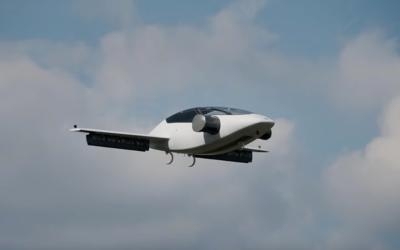Unveils 5 Seat Model For Use As On-Demand Air Taxi
A series of rigorous flight tests have taken place in the skies above Germany with the Lilium Jet, a zero-emission electric plane capable of VTOL operations. The two-seat prototype executed a range of complex maneuvers, including its signature mid-air transition from hover mode to wing-borne forward flight.

Lilium is now developing a larger, five-seater version of the Jet, designed for on-demand air taxi and ridesharing services.
“Seeing the Lilium Jet take to the sky and performing sophisticated maneuvers with apparent ease is testament to the skill and perseverance of our amazing team," said Lilium co-founder and CEO Daniel Wiegand. "We have solved some of the toughest engineering challenges in aviation to get to this point.
“The successful test flight program shows that our ground-breaking technical design works exactly as
we envisioned. We can now turn our focus to designing the five seater production aircraft.”
The Lilium Jet is 100% electrically powered, so creates no harmful emissions, making it a potential solution to deteriorating air quality in towns and cities, caused by road traffic, according to the company. It is also the only electric aircraft capable of both VTOL and jet-powered flight, using its wings for lift, similar to a conventional airplane.

This advanced capability consumes around 90% less energy than drone-style aircraft, enabling the Lilium Jet to achieve a range of more than 300 km (162 nm) with a maximum cruising speed of 162 knots. In flight, the aircraft's power consumption will be comparable to an electric car, according to the company. Take-off and landing for a Lilium Jet only requires a small open space or landing pad on a building - alleviating pressure on congested roads.
The combination of energy efficient flight and minimal ground infrastructure will enable passenger flights with comparable pricing to normal car taxis over the same distance.
Lilium projects that a typical journey by Lilium Jet will be at least 5 times faster than by car, with even greater efficiencies in busy cities. For example, a flight from Manhattan to New York’s JFK Airport will take around 5 minutes, compared to 55 minutes driving.
The ability of the Lilium Jet to travel long distances, quickly and at low cost will also open new opportunities for people to live further away from their place of work.
The Lilium Jet is a lightweight aircraft powered by 36 electric jet engines mounted to its wings via 12 moveable flaps. It is unique in combining the benefits of VTOL offered by helicopters and drones, with the speed and range of a jet aircraft.
At take-off, the Lilium Jet’s flaps are pointed downwards to provide vertical lift. Once airborne, the flaps gradually tilt into a horizontal position, providing forward thrust. When the wing flaps are horizontal, all of the lift required to keep the Lilium Jet in the air is provided by air passing over the wings - as with a conventional airplane.

Safety is of primary concern of Lilium, and the Jet is designed along the principle of Ultra Redundancy: The aircraft’s engines are individually shielded, so the failure of a single unit cannot affect adjacent
engines.
The aircraft's power cells are designed to continue delivering sufficient power for continued flight and a safe landing in the unlikely event that part of the battery configuration fails. Lilium’s Flight Envelope Protection System prevents the pilot from performing maneuvers that would take the aircraft beyond safe flight parameters.
(Images provided with Lilium news release and from YouTube video)
 Unfortunate... ANN/SportPlane Resource Guide Adds To Cautionary Advisories
Unfortunate... ANN/SportPlane Resource Guide Adds To Cautionary Advisories ANN FAQ: Turn On Post Notifications
ANN FAQ: Turn On Post Notifications ANN's Daily Aero-Term (04.29.24): Visual Approach Slope Indicator (VASI)
ANN's Daily Aero-Term (04.29.24): Visual Approach Slope Indicator (VASI) ANN's Daily Aero-Term (04.28.24): Airport Marking Aids
ANN's Daily Aero-Term (04.28.24): Airport Marking Aids ANN's Daily Aero-Linx (04.28.24)
ANN's Daily Aero-Linx (04.28.24)





